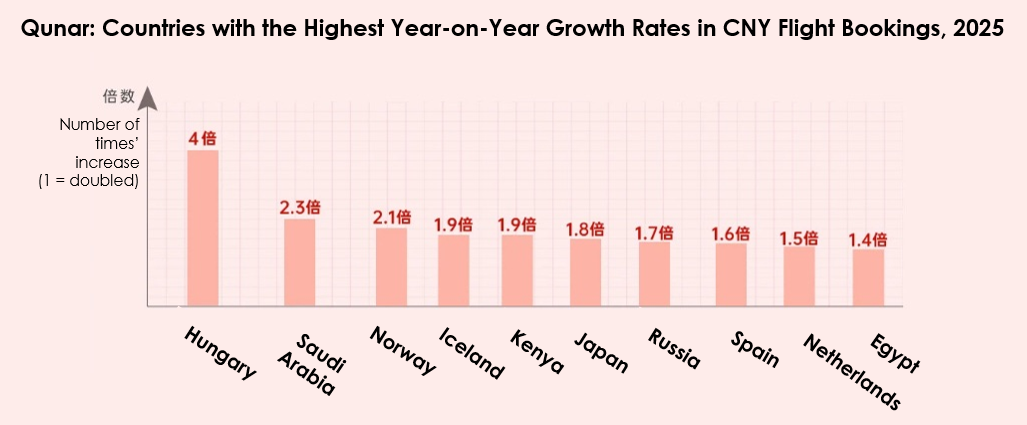
Vietnam was one of the big winners from 2025’s Chinese New Year holiday. Photo by Steffen Bertram for Unsplash.
Updated 6 February, 2025
The Chinese New Year holiday was extended to eight days in 2025, from 28 January-4 February. We’ve rounded up and translated all the news and reports on Chinese outbound travel during this holiday so far, and will update this post in the coming days as more information is released.
With a longer holiday and better flight connectivity, Chinese outbound tourism was up this Chinese New Year compared to last, with growth to both regional and long-haul destinations. There are now numerous countries welcoming more Chinese visitors than they did in 2019, including Malaysia, Japan, and Vietnam. Self-driving and family travel are once again major Chinese New Year travel trends.
Domestic Travel: Ministry of Culture and Tourism
According to data released on 5 February by the Ministry of Culture and Tourism, 501 million Chinese traveled domestically during the Chinese New Year holiday period, a 5.9% year-on-year increase. Tourism spending reached 6.77 billion RMB, a 7% increase. Cultural tourism was the biggest trend, and data from Tuniu shows that more than 60% of travel was done by family groups — including parents with children, and three generations traveling together.
National Immigration Authority
China’s National Immigration Authority recorded 14.366 million border crossings during the holiday period, an increase of 6.3% compared to last year. Mainland Chinese border crossings (both outbound and inbound) accounted for 7.671 million of these, a 5% year-on-year increase. Shanghai stood out as the biggest source market for outbound travel, followed by Shenzhen, Beijing, Guangzhou, Zhuhai, Chengdu, Chongqing, Qingdao, Tianjin, and Hangzhou.
China Tourism Academy
In an article published on 5 February, the China Tourism Academy reported that 3.78 million Chinese traveled outbound this Chinese New Year holiday, a 5.2% increase from last year. This amounts to around 60% of 2019’s 6.31 million outbound travelers. The China Tourism Academy reports that 907,600 of the trips were international (vs. “cross-border”, which includes Hong Kong and Macau), and that Japan, Singapore, South Korea, the US, Malaysia, Thailand, Vietnam, Australia, Myanmar, and Russia were the destinations for 63.8% of these trips.
Ctrip
On 4 February, Ctrip published their “2025 Spring Festival Travel Summary Report”. The full report includes data on domestic, outbound, and inbound travel, and can be accessed (in Chinese) here. This is the data on outbound travel:
Cross-border travel bookings on Ctrip grew by 30%. The most popular 10 outbound destinations were: Japan, Hong Kong, Thailand, Malaysia, Singapore, Australia, South Korea, USA, Macau, and Vietnam. Among short-haul destinations, Japan saw the most significant increase. Long-haul destinations saw healthy growth compared to last year, too, including USA (+53%), Spain (+82%), Italy (+56%), and France (+50%).
With greater experience and familiarity with traveling overseas, Chinese travel habits are diversifying, too. Ctrip data shows that overseas car rentals were up by 42% year on year. The average cost for car rentals was under RMB3,000, increasing just 3% over last year. The average length of car rental overseas was 6 days, and popular destinations for self driving travel included Los Angeles, Dubai, San Francisco, Bangkok, and Phuket. Also seeing a significant increase was overseas travel packages that included a driver, increasing by 20% over last year. The most popular five countries for travel with a driver were Japan, Thailand, Malaysia, Indonesia, and Australia. Airport transfer bookings on Ctrip also reached a new high, with transaction volumes increasing by 58% year on year. Japan, South Korea, and Thailand saw the most significant growth, with GMV for airport transfers in Japan increasing by 120%.
Qunar
Released on 4 February, Qunar’s Chinese New Year travel includes data on domestic, outbound, and inbound travel, and can be accessed (in Chinese) here. This is the data on outbound travel:
According to bookings on Qunar, Chinese tourists visited more than 2,100 overseas cities around the world this Chinese New Year, a 50% increase over last year. The top 10 countries with the highest increase in air tickets were: Hungary, Saudi Arabia, Norway, Iceland, Kenya, Japan, Russia, Spain, the Netherlands, and Egypt.

The most popular outbound destinations, based on flight and hotel bookings, included: Japan, Thailand, Malaysia, Hong Kong, South Korea, Singapore, Indonesia, the US, Vietnam, and Australia. Qunar researchers noted that although the human trafficking incident involving actor Wang Xing in January did impact travel to Thailand, Thailand was still the first choice for many Chinese tourists for the new year. However, Japan did replace Thailand as the top travel destination this CNY, with continued high growth.
Shanghai residents purchased the most outbound flight tickets out of all Chinese cities. The year on year growth rate, at 57%, was also highest among first and new first-tier cities. Outbound air tickets purchased by residents of Chongqing, Ningbo, and Suzhou also all increased by more than 50%. Also worth noting is that visa-free travel and decreasing flight and hotel prices are making outbound travel more accessible for residents of smaller towns and cities. Outbound travel bookings for residents of third tier and below cities made up more than one-third of bookings, doubling compared to last year. The lower-tier cities with the highest growth – more than tripling since last year – were Zhangjiakou in Hebei Province, Binzhou in Shandong, Ordos in Inner Mongolia, and Yangjiang in Guangdong.
Tuniu
Tuniu released their CNY travel data on 4 February. Outbound travel accounted for 30% of Tuniu’s CNY travel bookings this year, of which 21% was short-haul, and 9% was long-haul. Group tours accounted for 64% of short-haul bookings, and more than 90% of long-haul bookings.
The top short-haul outbound CNY destinations were: Japan, Thailand, Maldives, Indonesia, Singapore, Malaysia, Vietnam, Sri Lanka, South Korea, and Nepal.
The top long-haul destinations and tours were: New Zealand, UAE, Australia, Egypt, Russia, Turkiye, Morocco, Spain-Portugal, UK-Ireland, and France-Switzerland-Italy.
According to CNY booking data published by Tuniu on 6 January, the most popular island destinations were the Maldives, Bali, Phuket, Sentosa, and Phu Quoc. 43% of outbound island travel bookings were family travelers. Although the Maldives is well known as a honeymoon destination, 65% of the Chinese travelers who booked on Tuniu to go there over CNY were family travelers.
Tongcheng
Tongcheng released their CNY data on 4 February. Based on outbound hotel bookings, the top destinations for the holiday were: Hong Kong, Japan, Macau, Malaysia, Thailand, Singapore, South Korea, Vietnam, the UAE, and Australia.
The most popular flight routes were: Shanghai-Tokyo, Shanghai-Osaka, Qingdao-Seoul, Guangzhou-Bangkok, and Shanghai-Jeju Island.
Tongcheng’s report highlighted the rising popularity of off-the-beaten-track destinations in Japan and the Arctic. The destinations with the biggest increases in flights tickets sold this CNY were: Reykjavic, Iceland; Sharm el-Sheikh, Egypt; Oslo, Norway; Brussels, Belgium; Sapporo, Japan.
Like Qunar, Tongcheng also reported that outbound travel bookings made by residents of cities ranked third tier or below, more than doubled this Chinese New Year.
Mafengwo
Mafengwo’s CNY report was released on 5 February. The most popular outbound destinations were: Japan, Singapore, Malaysia, Australia, Indonesia, Thailand, Vietnam, New Zealand, South Korea, and Turkiye. The report highlighted the trend of coastal and tropical destinations, which were particularly popular with family travelers this Chinese New Year.
The report also revealed the rising popularity of very niche, off-the-beaten-track destinations and activities among young travelers. Chasing the Northern Lights in Murmansk, taking a polar ice breaker in Finland, going on a cruise of Milford Sound in New Zealand, and looking for wild koalas in New Zealand have all become “must-do” travel goals for young people.
Spring Tour
According to CNY highlights released by Spring Tour on 3 February, outbound travel bookings were up by 76% this year compared to last. Cruise passengers grew by 200%, and independent travel grew by 56%.
In addition to the most popular destinations of Japan, Thailand, Jeju Island (South Korea), and Singapore, other hot destinations for Spring Tour’s outbound travelers included Spain, Australia, Hungary, New Zealand, and Malaysia.
Millennials were Spring Tours’ core demographic, with 36.85% of travelers aged 30-49. Silver travel is also significant, with another 15.3% aged 60-69.
Regional Winners and Losers – Reported by Travel and Tour World
Vietnam emerged as a new travel hotspot this Spring Festival, with flight bookings from China up 35% year on year, and 70% above 2019’s levels. Ho Chi Minh City received 87,360 foreign arrivals during the Chinese New Year period, an increase of 16.5% year on year. Hotel occupancy was up 44.4% year on year. Other regional winners, Japan and Malaysia saw the biggest year-on-year increases in Chinese visitors, up 86% and 79%, respectively.
The “loser” this Chinese New Year was Thailand, with bookings down by 15.6%. Chinese tourism to Thailand is suffering significantly following the recent rescue of a Chinese actor from a human trafficking scheme, on the border of Thailand and Myanmar, and many travelers canceled their CNY trips to Thailand as a result.
Flight Master
According to Chinese aviation data shared by Flight Master, international flights during the Chinese New Year period were up to 89.8% of 2019’s levels – a healthy increase from the 74.8% recovery rate for 2024.
Scheduled flights to popular international destinations increased significantly this CNY:
However, some destinations saw significant declines in connectivity with China compared to 2019:
Alipay
Mobile payment provider Alipay reported a 30% increase in transactions overseas during the 2025 CNY period. The number of transactions in 2024 already surpassed pre-pandemic levels, though the total transaction volume in 2024 was still just 82% of 2019’s level. Alipay did not release data on the total transaction volume in 2025. However, top destinations saw big increases – Singapore, the most popular outbound destination for Alipay users, enjoyed a 56% year-on-year increase in total spend. Japan also had an increase of 40%. Malaysia, Hong Kong, and South Korea were the other top destinations for Alipay users. The number of Alipay transactions in Europe increased by 30% year on year. The top destinations were the UK, France, and Italy, with Switzerland, Austria, and Turkey enjoying “notable increases” according to Alipay’s report. The payment platform reported a whopping 449% increase in spending on cosmetic surgery overseas over Chinese New Year. Spending on food also grew by at least one-third, depending on the food category. Meanwhile, Alipay spending on local transport methods like bus, subway, and ride hailing platforms was up by 139%.
Register here for Dragon Trail’s 12 February webinar for a full round-up and analysis of Chinese New Year travel trends, and a deep dive on self-driving tourism from leading Chinese car rental platform Zuzuche.
Sign up for our free newsletter to keep up to date on our latest news
We do not share your details with any third parties. View our privacy policy.
This website or its third party tools use cookies, which are necessary to its functioning and required to achieve the purposes illustrated in the cookie policy. If you want to know more or withdraw your consent to all or some of the cookies, please refer to the cookie policy. By closing this banner, scrolling this page, clicking a link or continuing to browse otherwise, you agree to the use of cookies.